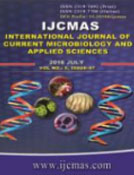


 National Academy of Agricultural Sciences (NAAS)
National Academy of Agricultural Sciences (NAAS)

|
PRINT ISSN : 2319-7692
Online ISSN : 2319-7706 Issues : 12 per year Publisher : Excellent Publishers Email : editorijcmas@gmail.com / submit@ijcmas.com Editor-in-chief: Dr.M.Prakash Index Copernicus ICV 2018: 95.39 NAAS RATING 2020: 5.38 |
Diabetic foot infections (DFI) are normally caused by microorganisms. They are usually inadequately managed due to misunderstanding of microbial prevalence and therapeutic approaches. This study aimed to detect pathogenic microorganisms in diabetic foot infection (DFI) of some Yemeni patients in Taiz City, and to investigate the sensitivity of isolated microorganisms to different antibiotics. Eighty samples were collected from (DFI) patients admitted in AL-Thowra hospital, and Al-Gomhory Hospital in Taiz City through study period. The rates of patients who got diabetic foot infection were 61% males and 39% females. Their ages range between 32 – 85 years. The ratio of patients who got amputation was 26%. Gram positive bacteria were responsible of 67% of DFI cases followed by Gram negative bacteria in 28% and yeasts in 5% of cases. The most commonly isolated microorganisms from the diabetic foot ulcers were Pseudomonas aeruginosa (37.8%) and Staphylococcus aureus (18.9%), followed by Escherichia coli (11.1%), Klebsiella pneumoniae (11.1%) and Candida albicans (5.6%). Other isolates were recorded in low frequencies.
 |
 |
 |
 |
 |